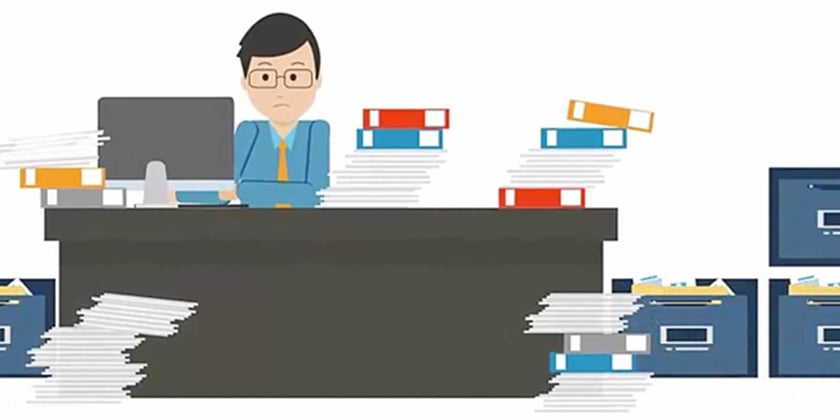Old school accounts payable (AP) processes?
Why does your AP team have to put up with all these inefficiencies, when the technology exists to automate approvals, reminders and storage?
Identify bottlenecks and gain visibility over what you’re missing. With AP automation, your processes just got a whole lot easier.
Eight Ways AP Automation Makes a difference for Your Entire Organizationhttps://info.loffler.com/document-management-contact-an-expert
Organizations of all sizes and industries are continually trying to reduce operational costs and improve efficiencies. Paper-intensive business processes such as accounts payable (AP) invoice processing are a good place to start.
At most organizations, the AP processes are still manual in nature, which can be burdensome to an organization in terms of limited visibility over invoice processing, costly reconciliation process, loss of early pay discounts, decreased cash flow and deteriorating vendor relationships.
By implementing AP automation with a document management system, organizations will have the following benefits:
1. Reduce time to process invoices and ensure 100% of early pay discounts are captured
Two weeks is too long to process an invoice. Between time the invoice is received, sent to an approver and returned to the finance department for a check to be cut, 14 days have passed. When the early-pay discount for the invoice is net 10 days, you would have missed the discount due to an outdated, manual process. On a $100,000 invoice, with a 3% early-pay discount, that’s $3,000 you are losing. AP automation pushes invoices to an approver and reminds them an approval is needed, without your AP team needing to do so. This helps the invoice get back to the finance department faster, with less babysitting, and helps you pay invoices in time to take advantage of discounts.
2. Mitigate manual data entry and the errors associated with it
Using OCR (optical character recognition) automated data capture on your invoices takes the information from the invoice and imports it directly into your document management system. Because employees aren’t manually typing in the data, human entry error will be eliminated. Data that is automatically captured and can then be sent to a verifier to confirm the invoice is correct. Intelligent automation capture is valuable to any AP department and can be customized to your needs.
3. Increase visibility over your entire AP process to simplify reconciliation
Storing purchase orders, packing slips and invoices in your document management software will allow to you see whether or not you have all documents in order to pay a bill. Having this information at a glance helps accounting managers and CFOs see how much money they can expect to be paid out the coming days, so they can monitor and control cash flow. This helps them determine when to make strategic business decisions quickly, efficiently and accurately.
4. More accurate and possibly real-time financial information allows for informed business decisions
With manual AP processes, your accounting department may not know an invoice has arrived until they physically receive it; multiple people may handle an invoice before accounting even knows it exists. In some organizations, invoices go to accounting first, and in that case it’s even more steps for the accounting department, because they then need to seek out proper approvals to get an invoice paid. And that’s assuming the person processing the incoming mail has manually routed invoices to the correct person. If they choose the wrong person, or mistake an invoice for something else, it could wind up unchecked in a mailbox for even more time. AP automation allows for an invoice to be input electronically into a document management system, and for those who need to know about the invoice to be notified right away. No more letting an invoice sit unnoticed.
5. Improved vendor relationships
Automated AP solutions help you pay your invoices on time, which helps to facilitate trusting and long-term relationships with your vendors. In addition, because AP automation helps decision makers at your organization see cash flow expectations, they can better work with vendors to take advantage of discounts when they make sense for your organization.
What does AP automation really look like in practice?
Every organization goes about their AP processes differently. You know your organization’s processes better than any vendor ever could. By implementing a document management system to facilitate AP automation in your organization, you’re not instilling new processes to change the way you do things. In contrast, a document management system can be molded into your existing processes and facilitate automations to make your processes happen more efficiently and with less manual intervention by your AP team. Consider these three key automations that will revitalize your AP processes:
1. Approval Process Workflows
Route invoice approvals through your organization automatically via email using your document management system. If your process requires the invoice first go to the purchaser, then to their manager and then to the CFO, it will push the approval from person to person. You can design different scenarios for approval processes depending on who needs visibility. Is there a dollar amount that only certain people can approve? For example, anything above $10,000 goes directly to the CFO? Or perhaps to the purchaser’s direct manager, and then the CFO?
This process without AP automation would need to go from desk to desk of each approver (people signing off on paper invoices). AP automation, facilitated through a document management system, allows approval through email notifications. A document management system knows how many levels of approval an invoice needs based on several factors, which could include the invoice amount, the purchaser, their department or the cost center. Rules within the workflow can be built to meet your organization’s unique needs. What your actual workflows look like will depend on how many levels of approvers your organization has.
2. Reminders
A reminding email can be sent from your document management system to an approver. You could set a reminder email to be sent every two days, every week or even every minute, depending on how persistent you want to be and the level of automation you want to achieve.
Reminder email notifications can be customized to fit the person who needs to approve the information and what key information they need to see right away in order to make a business decision. Additional reminder customizations include sending emails to multiple recipients, sending a link to the invoice and inserting an invoice number in the subject line.
Reminders remove the need for AP to manually track down approvals for an outstanding invoice. The document management system also gives AP visibility as to whether an invoice is still waiting for approval in someone’s queue or has been approved and sent on to the next level of approver. This makes it easy to identify bottlenecks within an approval process.
Many organizations also find this ability useful for Human Resources.
3. Automated Digital Storage
Many organizations face requirements for retention of invoices, with a common time frame being seven years. During an audit, if you have more than seven years of invoices, auditors are allowed to look at everything you have. A document management system can automate the retentions process, where the system looks for any invoices older than seven years and presents it to a user. At that point, the user can choose whether to delete if out of the system. This automated notification of expired retention requirements helps you mitigate risk associated with an audit. No invoices would ever be deleted automatically; it would only be the notification that is automated.
Interested in learning more about document management?
REQUEST A FREE DOCUMENT MANAGEMENT CONSULTATION
Read Next: How Does Accounts Payable Automation Work?

Jeff King is the Sr. Director of Intelligent Automation at Loffler Companies. He’s been with the company since 2006, delivering a high level of value to clients with his consultative approach to digital transformation, business process automation, content intelligence, security, managed print services and project management. In his free time Jeff enjoys fitness, traveling and spending time with his family.



